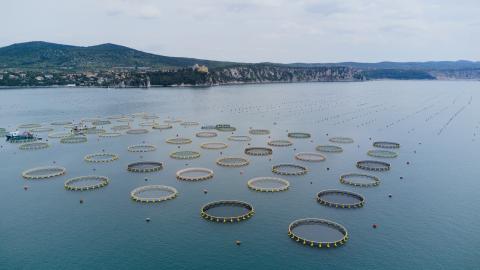Aree
MARITIME SPATIAL PLANNING: MARINE AREAS AND SITES FOR AQUACULTURE
Data aggiornamento scheda:

This indicator reports national scale data on the surface area and number of maritime state concession areas for aquaculture use as well as on Allocated Zones for Aquaculture (AZA). AZAs are designated by the competent authority as “Priority Areas for Aquaculture”, meaning areas free from conflicts with other uses and with environmental conditions suitable to ensure sustainable production while minimizing environmental impacts.
In Europe, identifying new marine areas for aquaculture is one of the main objectives of the Strategic Guidelines for a more sustainable and competitive EU aquaculture for 2021–2030 (COM/2021/236), of the National Strategic Aquaculture Plans 2014–2020 and 2021–2027, and of the corresponding EMFF and EMFAF Operational Programs, under Regulations 508/2014/EU and 1139/2021/EU.
The identification of AZAs is also part of the Maritime Spatial Planning (MSP) framework established by Directive 2014/89/EU, transposed into Italian law by Legislative Decree 201/2016, which supports the sustainable growth of maritime economies through a coordinated, integrated, and cross-border approach within Maritime Spatial Management Plans. These aquaculture planning processes are also relevant to climate change adaptation strategies needed to mitigate medium- and long-term sector impacts.
Italy’s maritime space, between the coastline and the 12-nautical-mile limit, covers approximately 14 million hectares. Of this area, only 20,250 hectares are currently occupied by state concessions for aquaculture use, with around 96% (19,445 ha) allocated to shellfish farming and only 3.9% (805 ha) to marine fish farming. As of April 2024, AZAs have been designated in Tuscany, Marche, Emilia-Romagna, Veneto, and Friuli-Venezia Giulia, for a total area of about 29,633 hectares. Within AZAs, 8,739 ha are occupied by shellfish farming and 665 ha by fish farming.
OVEREXPLOITED FISH STOCKS
Data aggiornamento scheda:
During the 2007-2022 period, the majority of the assessed fish stocks are in a state of overexploitation: the fishing-induced mortality is higher than that necessary for a sustainable exploitation of the resources in the long term under average environmental conditions.
In the 2020-2022 triennium, the lowest values in the historical series were recorded, with approximately 60% of stocks classified as overexploited, indicating a relative improvement.
This indicator, based on internationally validated analytical stock assessments, reflects the overall trend in the exploitation status of commercially fished stocks, highlighting the condition of harvested resources. The indicator is also associated with the percentage coverage of landed fish stocks for which stock assessments are available. The analysis is conducted at both the national and subregional levels, following the geographic division defined by the Marine Strategy Framework Directive.
AQUACULTURE COMPANIES AND PRODUCTION
Data aggiornamento scheda:
The indicator estimates the size of national aquaculture in terms of the number of active facilities and production volumes, as well as production trends in relation to the objectives set in the Strategic Aquaculture Plan 2014-2020 and the Operational Program of the European Maritime and Fisheries Fund (EMFF OP) 2014-2020.
In 2020, Veneto remained the leading region in Italy in terms of the number of facilities (26%), while Emilia-Romagna was the largest producer by volume (26%). Five regions (Veneto, Emilia-Romagna, Friuli-Venezia Giulia, Puglia, and Sardinia) host 71% of Italy’s aquaculture facilities. Emilia-Romagna, Veneto, and Friuli are confirmed the main producers, and together with Marche and Tuscany, they account for 69% of national production.
Most coastal regions, depend on marine aquaculture, with facilities located in transitional, coastal, and marine environments.
The year 2020 was negatively impacted by the Covid-19 pandemic: the Italian aquaculture production was 122,760 tons, of which 61% were bivalve shellfish and 39% were fish. Crustacean farming remains a minor sector, with a production of only 0.5 tons. Alien species account for 49% of national production. Due to the production decline recorded in 2020, overall aquaculture production between 2013 and 2020 decreased by 13%, failing to meet the growth projections set by the Ministry of Agricultural, Food and Forestry Policies (MiPAAF).